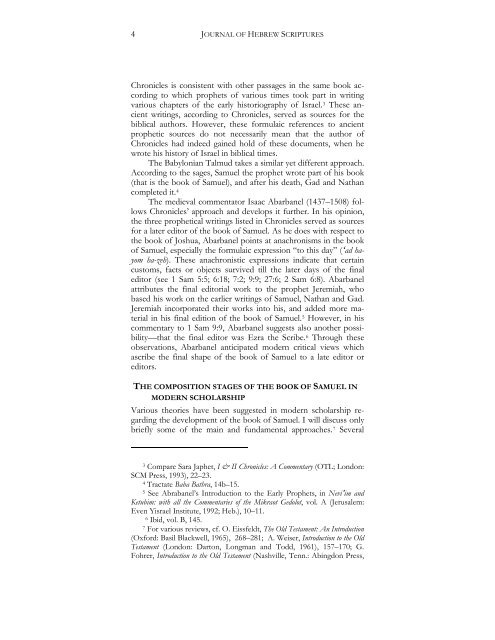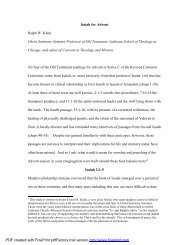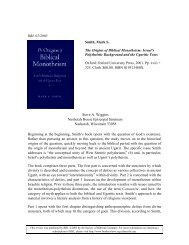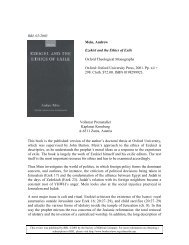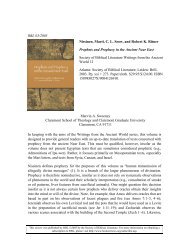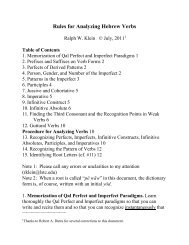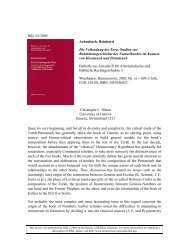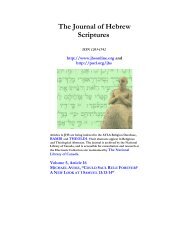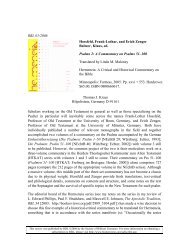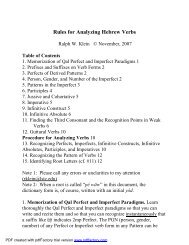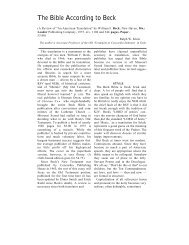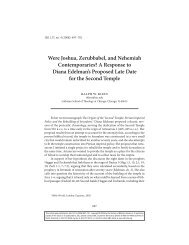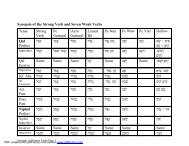The Book of Samuel: Its Composition, Structure and Significance as ...
The Book of Samuel: Its Composition, Structure and Significance as ...
The Book of Samuel: Its Composition, Structure and Significance as ...
Create successful ePaper yourself
Turn your PDF publications into a flip-book with our unique Google optimized e-Paper software.
4 JOURNAL OF HEBREW SCRIPTURES<br />
Chronicles is consistent with other p<strong>as</strong>sages in the same book according<br />
to which prophets <strong>of</strong> various times took part in writing<br />
various chapters <strong>of</strong> the early historiography <strong>of</strong> Israel. 3 <strong>The</strong>se ancient<br />
writings, according to Chronicles, served <strong>as</strong> sources for the<br />
biblical authors. However, these formulaic references to ancient<br />
prophetic sources do not necessarily mean that the author <strong>of</strong><br />
Chronicles had indeed gained hold <strong>of</strong> these documents, when he<br />
wrote his history <strong>of</strong> Israel in biblical times.<br />
<strong>The</strong> Babylonian Talmud takes a similar yet different approach.<br />
According to the sages, <strong>Samuel</strong> the prophet wrote part <strong>of</strong> his book<br />
(that is the book <strong>of</strong> <strong>Samuel</strong>), <strong>and</strong> after his death, Gad <strong>and</strong> Nathan<br />
completed it. 4<br />
<strong>The</strong> medieval commentator Isaac Abarbanel (1437–1508) follows<br />
Chronicles’ approach <strong>and</strong> develops it further. In his opinion,<br />
the three prophetical writings listed in Chronicles served <strong>as</strong> sources<br />
for a later editor <strong>of</strong> the book <strong>of</strong> <strong>Samuel</strong>. As he does with respect to<br />
the book <strong>of</strong> Joshua, Abarbanel points at anachronisms in the book<br />
<strong>of</strong> <strong>Samuel</strong>, especially the formulaic expression “to this day” (‘ad hayom<br />
ha-zeh). <strong>The</strong>se anachronistic expressions indicate that certain<br />
customs, facts or objects survived till the later days <strong>of</strong> the final<br />
editor (see 1 Sam 5:5; 6:18; 7:2; 9:9; 27:6; 2 Sam 6:8). Abarbanel<br />
attributes the final editorial work to the prophet Jeremiah, who<br />
b<strong>as</strong>ed his work on the earlier writings <strong>of</strong> <strong>Samuel</strong>, Nathan <strong>and</strong> Gad.<br />
Jeremiah incorporated their works into his, <strong>and</strong> added more material<br />
in his final edition <strong>of</strong> the book <strong>of</strong> <strong>Samuel</strong>. 5 However, in his<br />
commentary to 1 Sam 9:9, Abarbanel suggests also another possibility—that<br />
the final editor w<strong>as</strong> Ezra the Scribe. 6 Through these<br />
observations, Abarbanel anticipated modern critical views which<br />
<strong>as</strong>cribe the final shape <strong>of</strong> the book <strong>of</strong> <strong>Samuel</strong> to a late editor or<br />
editors.<br />
THE COMPOSITION STAGES OF THE BOOK OF SAMUEL IN<br />
MODERN SCHOLARSHIP<br />
Various theories have been suggested in modern scholarship regarding<br />
the development <strong>of</strong> the book <strong>of</strong> <strong>Samuel</strong>. I will discuss only<br />
briefly some <strong>of</strong> the main <strong>and</strong> fundamental approaches. 7 Several<br />
3 Compare Sara Japhet, I & II Chronicles: A Commentary (OTL; London:<br />
SCM Press, 1993), 22–23.<br />
4 Tractate Baba Bathra, 14b–15.<br />
5 See Abrabanel’s Introduction to the Early Prophets, in Nevi’im <strong>and</strong><br />
Ketubim: with all the Commentaries <strong>of</strong> the Mikraot Gedolot, vol. A (Jerusalem:<br />
Even Yisrael Institute, 1992; Heb.), 10–11.<br />
6 Ibid, vol. B, 145.<br />
7 For various reviews, cf. O. Eissfeldt, <strong>The</strong> Old Testament: An Introduction<br />
(Oxford: B<strong>as</strong>il Blackwell, 1965), 268–281; A. Weiser, Introduction to the Old<br />
Testament (London: Darton, Longman <strong>and</strong> Todd, 1961), 157–170; G.<br />
Fohrer, Introduction to the Old Testament (N<strong>as</strong>hville, Tenn.: Abingdon Press,


